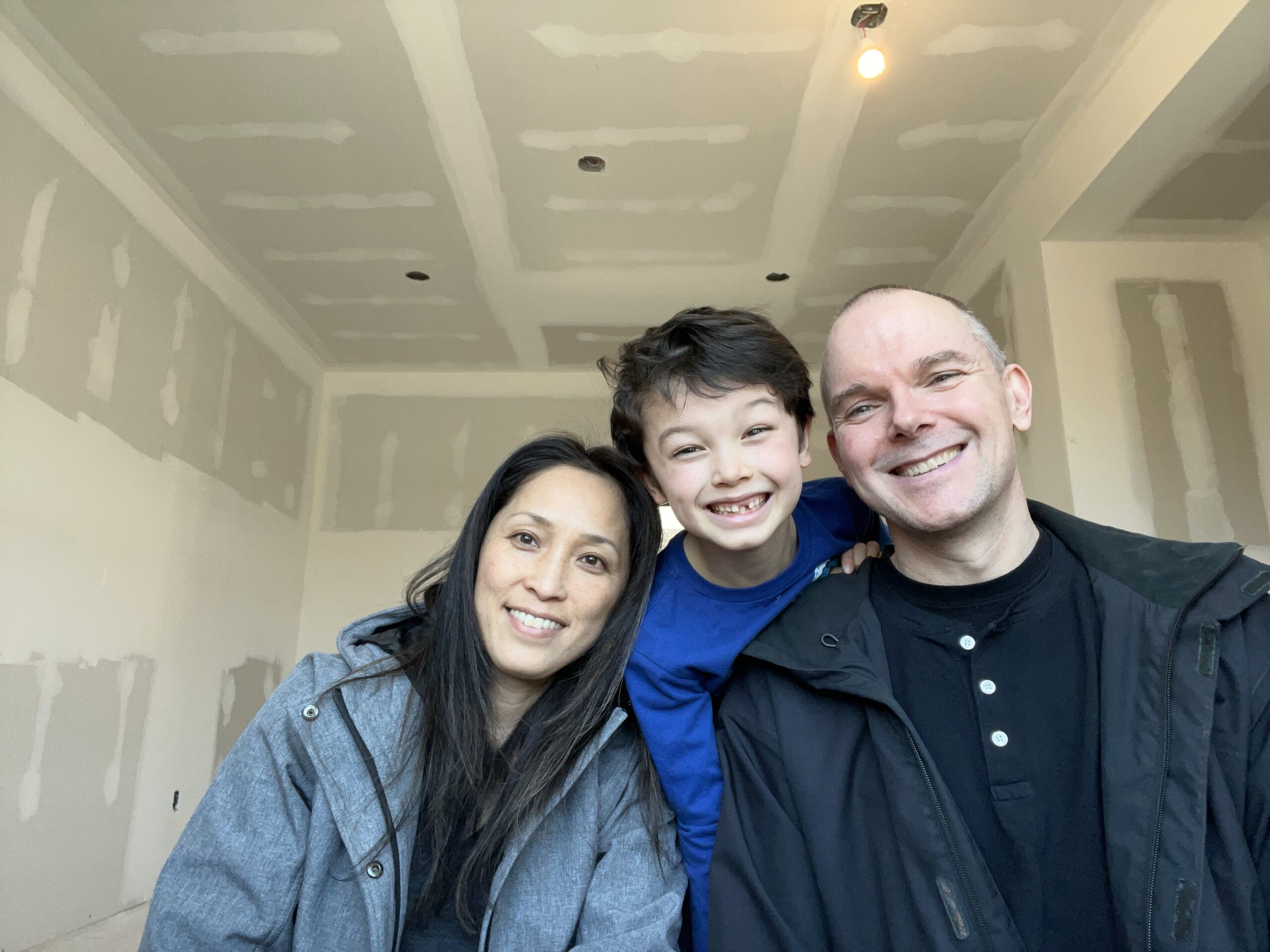For many Canadians, energy efficiency is not top-of-mind when they imagine their ‘dream home.’ But Daragh Hayes was part of a growing number of Canadians who do dream about building an energy-efficient home. With the help of Just Working Construction, Daragh’s dream is quickly becoming a reality. But this dream-come-true had a nightmarish beginning.
Daragh and Yuki Hayes were raising their son in a modest bungalow in a single-dwelling neighbourhood in London, ON. Two and a half years ago, when their home caught on fire during a contracted renovation, their lives changed abruptly. After many unsuccessful restorative efforts, the house was deemed unlivable. A new home would have to be built.
A vision for a beautiful home energy-efficient home
Daragh and Yuki spent long months waiting for a settlement to be finalized by the insurance company. During this time, Daragh began to see the tragic loss of their home as the opportunity for a new beginning. He wanted to create an environmentally sustainable home that his young son would appreciate a generation from now. He envisioned a comfortable home that was also highly energy-efficient.
Environmental concerns have influenced Daragh’s lifestyle decisions for many years. Until his family was forced to relocate after the fire, he had never driven a car to work. He and Yuki bring their own jars and containers when they buy coffee and produce at Reimagine Co. groceries. His commitment to being vegan is another way he seeks to reduce his carbon footprint.
Turning the dream into a reality
Daragh was intrigued by the Passive House movement in Europe and Canada. Passive house (or ‘PassivHauss’) is a voluntary standard for building energy-efficient homes and other buildings. He was determined to drastically reduce his use of fossil fuels to heat their new home.
Daragh looked into building a prefabricated passive house. However, he learned that a prefab solution would not work for him and his family. The prefab plans that were available could not accommodate either a basement or his lot size and constraints.
Daragh turned to the local construction industry. He couldn’t find a single local builder who was willing or able to use optimal energy-efficient methods and materials. Instead, they tried to sell Daragh on high-end countertops and other luxury finishes. But Daragh wouldn’t be swayed.
Daragh was thrilled when he found Just Working Construction, located just an hour from London. The JWC team shared Daragh’s passion for building using passive house principles, standards, and materials. They engaged Danielle Gignac, a senior architect at Invizij to create the initial design for the Hayes’ home. Danielle has been certified as a Passive House Designer since 2019.
Meeting expectations for an energy-efficient building envelope
Passive house certification includes rigorous standards designed to achieve a highly energy-efficient building envelope. A building envelope provides a system of protection against the extremes of cold and heat in our Canadian climate. It also protects the home from unwanted moisture. Houses built according to passive house standards can reduce a home’s heat consumption by up to 90%.
While Canadian building requirements for energy efficiency are increasing, they remain far below the requirements for passive house certification. Passive house certification standards also significantly exceed Canada’s R2000 standards for energy efficiency. And they include performance standards both for airtightness and for how much heat is required to maintain a comfortable temperature.
Energy efficiency and the ‘building envelope’
The building envelope includes the external wall systems, the foundation, roof, windows and doors, and the ventilation system. JWC incorporated the following methods and materials in designing and constructing the building envelope of the Hayes’ home. These either met or exceeded both Canadian and passive house standards:
- Continuous insulation from the foundation to the attic ceiling
- A fully airtight barrier around the building envelope
- Permeable vapour membranes that allow moisture to escape from within the building envelope
- Highly insular, well-installed windows and doors
- Minimizing heat loss due to heat-conductive pathways (thermal bridges) to the home’s exterior
- A ventilation system which conditions the air and reclaims escaping thermal energy
The passive home performance standards: an achievable dream
Adam is confident the Hayes’ home will meet or surpass passive house performance standards for airtightness and heat load. Heat load refers to the energy needed to maintain a comfortable temperature within the home. Airtightness is measured by a blower door test.
An initial blower door test was done to identify and troubleshoot any air leaks within the building envelope. Adam was very pleased with the initial results, which indicated the house allowed only .21 to .22 “air changes” per hour. This air exchange rate is only one-third of passive house allowances and a mere 15% of Canada’s R2000 standards. The testing was done before the drywalling, but Adam is confident that the home will be significantly more airtight than either Passive House or R2000 standards require. Just Working Construction achieved these results because of their careful installation of high-quality insulation and vapour barrier products.
Insulation and vapour barriers: creating airtightness and a lower heat load
Achieving passive house performance standards for airtightness and a lower heat load requires optimal products, design, and execution. Just Working Construction used high-quality insulation including Rockwool and rigid foam insulation. They carefully insulated the home’s building envelope, from below the foundation to above the attic ceiling. However, even the best insulation is ineffective for lowering the heat load if the building envelope is not airtight.
Properly installing vapour barriers and vapour control barriers was also an important part of JWC’s strategy. The Just Working team installed a polypropylene vapour barrier underneath the insulated foundation slab. They extended this vapour barrier to wrap around the foundation walls. It was then ‘tied to’ the SIGA Majvest® vapour control barriers on the exterior wall. This vapour control system is designed to be wind- and waterproof while allowing vapour to escape to the exterior. SIGA products, manufactured in Switzerland, are passive-house-approved products.
Insulating and conditioning the interior of the home
On the interior side of the walls, the Just Working team used SIGA Majrex vapour control barrier sheets to make every interior space airtight. “At each level, we’ve wrapped the vapour barriers around the framing, Adam explains. “We’ve done this to make it continuous through all the different connection points. We’ve done this all the way up to the attic. We’ve connected it to a vapour barrier on the underside of the attic space.”
They also used SIGA sealing tape products for careful detailing around potential thermal bridges which allow energy to escape. Thermal bridges can include window-wall interfaces, chimneys, and building corners. This careful sealing of the interior spaces has resulted in the very low ‘air exchange’ numbers Adam talked about.
Vapour control barriers prevent humidity from escaping from the living spaces into the building envelope where moisture could accumulate. But they do allow moisture to escape the other way, from the building envelope into the home’s interior. This excess moisture can then be moved from the home’s interior to outside the building through the ventilation system.
Ventilation for air quality and energy efficiency
With an airtight interior, a mechanical air exchanger is needed to vent stale, humid air and to bring in fresh air. This fresh air can also be filtered to reduce the pollens and pollution we are exposed to within our homes.
Adam Vandersleen recommended an ERV, an energy recovery ventilation system, for the Hayes’ home. “You can use your mechanical ERV system to control the humidity and the heat. You’re capturing as much warm air as possible and you’re using that energy to recondition the new air coming in.”
A scaled-down dream: constraints and compromises
While Daragh and Yuki’s home aligns with passive house standards, they decided not to pursue the passive certification process. The compliance process would have added significantly to the cost of building their home, without providing any material benefit.
Although Daragh would have liked to install a ground-source heat pump, the cost proved prohibitive. And while his new home is solar power-ready, he had hoped to have solar panels operational from the start.
These alternative energy sources would have made his new home net zero, generating more energy than it consumed. A net-zero home is a goal that Daragh has set his sights on for the future.
Daragh envisioned incorporating other home enhancements to support a sustainable environment. He hoped to construct a rain garden to conserve groundwater. He also envisioned beautiful heat-tolerant lawn grasses growing in his yard, and a permeable driveway to minimize rainwater run-off. But these environmentally friendly projects will have to wait for now.
One important upgrade
Daragh did decide partway through construction that he wanted to upgrade the basement to create a rental unit. This bold investment will provide a source of income for the Hayes family as they pay off their home.
Working with the Just Working team
Daragh credits Adam Vandersleen with helping him navigate the complexities of energy-efficient construction technology. He helped him find optimum solutions throughout the project and to make compromises where necessary.
The team at Just Working Construction worked closely with Daragh from the early stages of the project. Their expert guidance helped the Hayes family create a beautiful home that models energy efficiency for the next generation.

